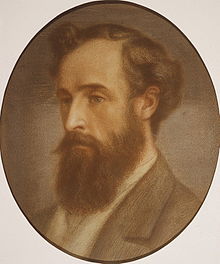Leyland Line
| Frederick Richards Leyland | |
|---|---|

Head of Frederick Leyland, 1879 by Dante Gabriel Rossetti
|
|
| Born | September 30, 1831 |
| Died | January 4, 1892 (aged 60) |
| Burial place |
Brompton Cemetery 51°29′5″N 0°11′26″W / 51.48472°N 0.19056°W |
| Residence | Liverpool, England |
| Nationality | British |
| Occupation | Shipowner |
| Known for | Shipowner and art collector |
Frederick Richards Leyland (30 September 1831 – 4 January 1892) was one of the largest British shipowners, running 25 steamships in the transatlantic trade. He was also a major art collector, who commissioned works from several of the Pre-Raphaelite painters.
Leyland served as an apprentice in the firm of John Bibby, Sons & Co, where he rose to become a partner. In 1867, he took on the tenancy of Speke Hall, Liverpool, and in 1869 bought a house in London at 49 Princes Gate. At the end of 1872, when the Bibby partnership dissolved, he bought out his employers and changed the company name to the Leyland Line in 1873. Under his direction the line expanded into transatlantic trade and by 1882 had 25 steamships. He retired from active business in 1888, leaving his son Frederick Dawson Leyland in charge.
Leyland's first commissions were to Rossetti and James McNeill Whistler, and date from 1864 and 1867. Leyland collected Renaissance art, as well as that of the Pre-Raphaelites, Whistler and Albert Moore.
Leyland commissioned The Beguiling of Merlin, a painting by the Pre-Raphaelite painter Edward Burne-Jones, which was created between 1872 and 1877. The painting depicts a scene from Arthurian legend, the infatuation of Merlin with the Lady of the Lake, Nimue. Merlin is shown trapped, helpless in a hawthorn bush as Nimue reads from a book of spells.
In the 1870s, Leyland commissioned Whistler to decorate his dining room. The resulting Peacock Room is considered one of Whistler's greatest works. After Leyland's death, his widow sold the Peacock Room to the American industrialist and art collector Charles Lang Freer who had it dismantled and shipped to the United States. It now resides in the Smithsonian Museum's Freer Gallery of Art in Washington, DC.
Leyland died in 1892, one of the largest shipowners in Britain, and is buried in Brompton Cemetery, London.[1] The grave is 10m west of the main path between the north entrance and colonnade but is highly recognizable due to its unique form and design.
...
Wikipedia
